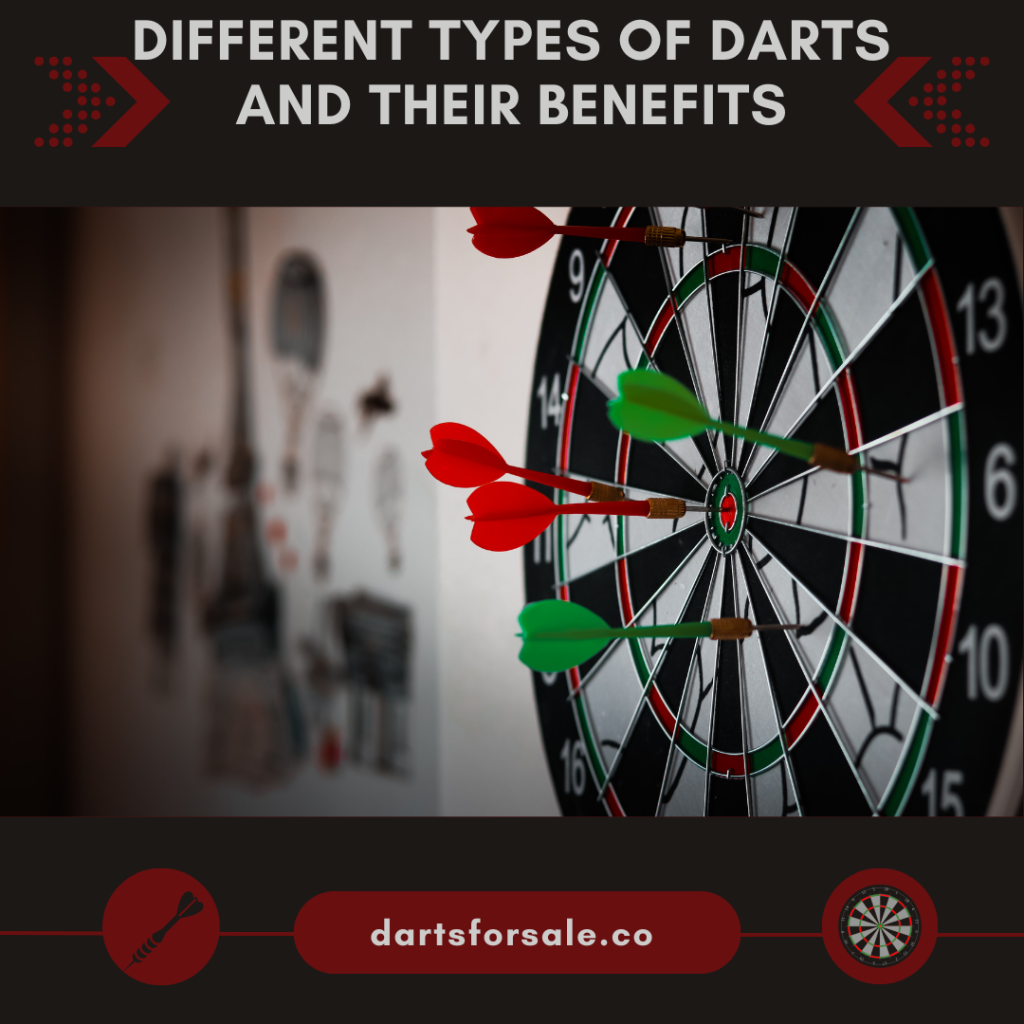Different Types of Darts and Their Benefits 
1. Steel-Tip Darts
- Materials: Made from brass, nickel-silver, or tungsten alloy.
- Benefits: These darts are primarily used for traditional dartboard games. They offer superior penetration, which reduces bounce-outs and enhances accuracy.
2. Soft-Tip Darts
- Materials: Typically made from plastic, allowing flexibility and reducing the risk of injury.
- Benefits: Soft-tip darts are commonly used with electronic dartboards. They are safer to use, especially in family environments, and are known for their ease of use and versatility.
3. Brass Darts
- Materials: Made entirely from brass.
- Benefits: Brass darts are affordable and suitable for beginners. They provide consistent flight and are ideal for players with a lighter throwing motion.
4. Nickel-Silver Darts
- Materials: Made from an alloy of copper, nickel, and zinc.
- Benefits: Nickel-silver darts have a sleek and eye-catching appearance. They offer better grip than brass darts and are an excellent choice for intermediate players.
5. Tungsten Darts
- Materials: Made from a tungsten alloy, one of the densest materials.
- Benefits: Tungsten darts are perfect for professional players due to their slim profile and exceptional durability. They maintain stability in the air and allow for tight groupings.
6. Precision Darts
- Materials: Usually made from high-quality tungsten or a tungsten alloy.
- Benefits: Precision darts are engineered to minimize air resistance, resulting in higher accuracy. They often feature intricate grip patterns and advanced technology, catering to experienced dart players.
7. Fixed-Point Darts
- Design: Have stationary tips that are non-replaceable.
- Benefits: Fixed-point darts are primarily used in professional tournaments. Their immovable tips ensure consistent weight distribution and eliminate the risk of weak spots caused by insert replacement.
8. Replaceable-Point Darts
- Design: Feature removable tips designed to be replaced as needed.
- Benefits: These darts allow customization for personal preference and accommodate various playing surfaces. They are often favored by players who desire flexibility and versatility.
9. Feather Flights
- Design: Made from real feather or synthetic materials.
- Benefits: Feather flights provide a higher level of stability and control during flight. They are suitable for players who prefer a slower and more consistent descent, allowing for precise targeting.
10. Standard Flights
- Design: Shaped like a conventional triangle, usually made from plastic.
- Benefits: Standard flights are the most common type and offer reliable performance. They provide a balanced trajectory and are suitable for players of all skill levels.
11. Slim Flights
- Design: Similar to standard flights but with a more streamlined shape.
- Benefits: Slim flights are known for improving speed and reducing drag. They allow darts to travel through the air with less resistance, making them ideal for players who prefer a faster throw or lighter darts.
12. Shape Flights
- Design: Come in various shapes like pear, kite, or teardrop.
- Benefits: Shaped flights affect the dart’s trajectory, allowing players to customize their throw. Different shapes offer unique stability, lift, or maneuverability, enhancing individual playing styles.
13. L-style Flights
- Design: Characterized by a low-profile, integrated flight and shaft system.
- Benefits: L-style flights minimize deflection and allow for tighter grouping. Their low-profile design reduces bounce-outs and ensures smooth entry into the dartboard.
14. Spinning Flights
- Design: Equipped with a spinning mechanism, allowing the flight to rotate freely.
- Benefits: Spinning flights stabilize the dart’s trajectory mid-flight, reducing the chances of tilting or wobbling. This allows for better accuracy and can be particularly beneficial for players experiencing consistency issues.
15. Glow-in-the-Dark Flights
- Design: Designed to glow in the dark, enhancing visibility in low-light conditions.
- Benefits: Glow-in-the-dark flights are ideal for playing in dimly lit rooms or during night-time dart games. They add a fun and unique element to the game, ensuring clear visibility of the dart’s trajectory.
Conclusion
Choosing the right darts is crucial to enhance your dart-throwing experience. The different types of darts discussed in this article cater to various preferences and skill levels, ensuring there is a perfect fit for everyone. Whether you prioritize accuracy, flexibility, or style, understanding the benefits of each dart type will help you make an informed decision. So, go ahead and experiment with different darts to find the ones that elevate your game to new heights!











